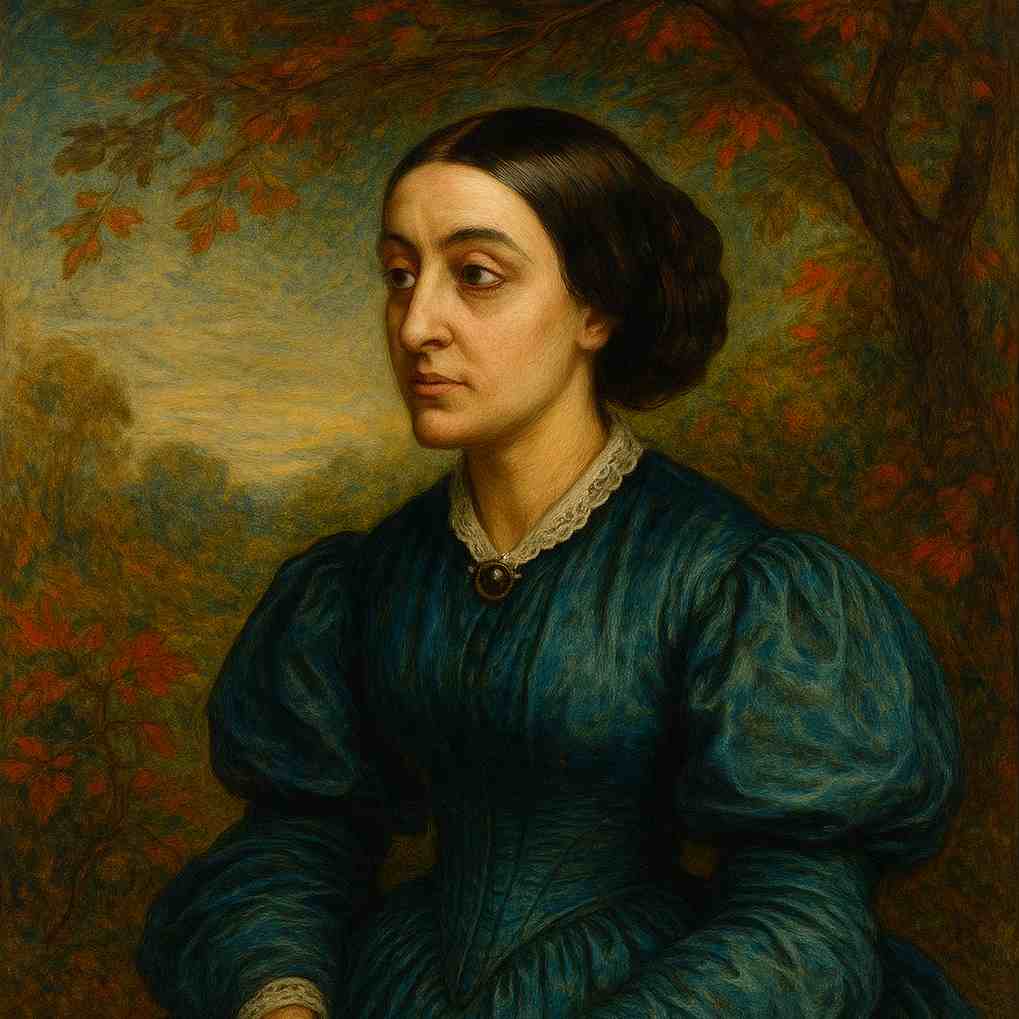A Better Resurrection
Christina Rossetti
1830 to 1894

Want to track your favorites? Reopen or create a unique username. No personal details are required!
I have no wit, no words, no tears;
My heart within me like a stone
Is numb'd too much for hopes or fears;
Look right, look left, I dwell alone;
I lift mine eyes, but dimm'd with grief
No everlasting hills I see;
My life is in the falling leaf:
O Jesus, quicken me.
My life is like a faded leaf,
My harvest dwindled to a husk:
Truly my life is void and brief
And tedious in the barren dusk;
My life is like a frozen thing,
No bud nor greenness can I see:
Yet rise it shall - the sap of Spring;
O Jesus, rise in me.
My life is like a broken bowl,
A broken bowl that cannot hold
One drop of water for my soul
Or cordial in the searching cold;
Cast in the fire the perish'd thing;
Melt and remould it, till it be
A royal cup for Him, my King:
O Jesus, drink of me.
Christina Rossetti's A Better Resurrection
Introduction
Christina Rossetti's poem "A Better Resurrection" stands as a profound exploration of spiritual desolation and the arduous path toward redemption. This three-stanza work, with its intricate imagery and deep emotional resonance, offers a rich tapestry for literary analysis. Through a careful examination of its structure, imagery, and thematic progression, we can uncover the complex interplay between human despair and divine hope that forms the core of Rossetti's poetic vision.
Structural Analysis
The poem's tripartite structure is not merely a formal choice but a deliberate architectural framework that mirrors the speaker's spiritual journey. Each stanza, consisting of eight lines with an ABABCDCD rhyme scheme, represents a distinct stage in this progression. This structure evokes the literary tradition of the Italian octave, a form often associated with contemplative or religious poetry, thus reinforcing the poem's spiritual themes.
The repetition of "My life is like" at the beginning of each stanza's fifth line creates a parallel structure that emphasizes the evolving metaphors for the speaker's existence. This repetition serves as a rhythmic anchor, providing continuity amidst the shifting imagery and emotional landscape of the poem.
Stanza-by-Stanza Analysis
Stanza 1: The Depths of Despair
The opening stanza plunges the reader into a state of profound emotional and spiritual desolation. The stark declaration "I have no wit, no words, no tears" immediately establishes a sense of complete emptiness. The caesura created by the commas in this line fragments the rhythm, mirroring the disjointed state of the speaker's psyche.
The metaphor of the heart "like a stone" evokes both the weight of grief and emotional petrification. This image is reinforced by the use of "numb'd," suggesting a paralysis of feeling that extends beyond mere sadness to a complete shutdown of emotional faculties.
The repetition of "look" in "Look right, look left, I dwell alone" creates a visual sweep that emphasizes the speaker's isolation. This line, coupled with the dimmed eyes that can no longer see the "everlasting hills," paints a picture of a soul cut off from both human companionship and divine presence.
The final couplet of this stanza introduces the central metaphor of life as a "falling leaf," a powerful image of decline and impending death. The direct address to Jesus in the last line, "O Jesus, quicken me," serves as both a plea and a turning point, introducing the possibility of divine intervention in this bleak landscape.
Stanza 2: The Stirrings of Hope
The second stanza builds upon the leaf metaphor, expanding it to encompass the speaker's entire existence. The "faded leaf" and "dwindled" harvest extend the autumnal imagery, suggesting not just personal decline but a broader sense of spiritual barrenness.
The description of life as "void and brief / And tedious in the barren dusk" is particularly striking. The juxtaposition of "brief" with "tedious" creates a paradoxical sense of time, where life feels simultaneously fleeting and interminable in its emptiness.
The introduction of the "frozen thing" metaphor marks a shift from autumn to winter, implying a further descent into spiritual coldness. However, this image also contains the first seeds of hope. The assertion "Yet rise it shall - the sap of Spring" introduces a note of certainty and anticipation, even in the midst of winter's grip.
The final line of this stanza, "O Jesus, rise in me," echoes the structure of the first stanza's ending but with a crucial difference. While the first stanza pleaded for quickening, this line invites a more profound indwelling, suggesting a deepening relationship between the speaker and the divine.
Stanza 3: Transformation and Union
The final stanza presents the most complex and transformative metaphor of the poem. The image of the "broken bowl" unable to hold water for the soul brilliantly encapsulates the speaker's sense of spiritual inadequacy and thirst.
The shift to imperative mood in "Cast in the fire the perish'd thing" marks a dramatic turn. The speaker now actively calls for their own destruction and reformation. This violent imagery of melting and remoulding evokes biblical allusions to the refiner's fire, suggesting a purification process.
The transformation of the broken bowl into a "royal cup for Him, my King" represents the ultimate spiritual aspiration - to become a vessel worthy of the divine. This image beautifully resolves the tension between human brokenness and divine purpose that has run throughout the poem.
The final line, "O Jesus, drink of me," completes the poem's spiritual arc. From the initial plea for quickening, through the invitation for Christ to rise within, we arrive at a state of complete offering and union. The reversal of the typical communion imagery (where the worshipper drinks of Christ) is a bold poetic choice, suggesting a reciprocal relationship between the human and the divine.
Thematic Analysis
The Journey from Despair to Hope
The poem traces a clear progression from utter despair to tentative hope and finally to transformative faith. This journey is not presented as a smooth or easy transition but as a process fraught with struggle and requiring divine intervention.
The Interplay of Human Agency and Divine Grace
Throughout the poem, there is a delicate balance between human helplessness and the potential for action. While the speaker begins in a state of complete paralysis, unable even to weep, by the end, they are actively calling for their own transformation. However, this transformation is only possible through divine action, highlighting the interdependence of human will and divine grace in Rossetti's spiritual vision.
The Paradox of Destruction and Renewal
Central to the poem's message is the idea that true spiritual renewal often requires a form of destruction or dissolution of the self. This paradox is most clearly expressed in the final stanza's imagery of being cast into the fire and remoulded, but it is prefigured in the earlier images of the falling leaf and the frozen thing that must thaw.
Seasonal Imagery and Spiritual Cycles
The poem's progression through autumnal and wintry imagery before hinting at spring suggests a cyclical view of spiritual life. This aligns with both natural cycles and the Christian liturgical calendar, implying that periods of desolation may be necessary precursors to renewal.
Conclusion
"A Better Resurrection" stands as a testament to Christina Rossetti's ability to weave complex theological concepts into deeply personal and emotionally resonant poetry. Through its carefully structured progression of metaphors and its nuanced exploration of the relationship between human despair and divine hope, the poem offers a profound meditation on the nature of spiritual transformation.
Rossetti's work invites readers to consider their own spiritual journeys, suggesting that even in the depths of desolation, the possibility of renewal and divine union remains. The poem's final image of becoming a vessel for the divine encapsulates a vision of spirituality that is both deeply humble and radically transformative, challenging readers to consider what it might mean to be not just quickened or inhabited by the divine, but to become a source of sustenance for God.
In its exploration of these themes, "A Better Resurrection" not only cements Rossetti's place as a major figure in Victorian religious poetry but also continues to speak to contemporary readers grappling with questions of faith, despair, and the possibility of spiritual renewal in an often challenging world.
This text was generated by AI and is for reference only. Learn more
Want to join the discussion? Reopen or create a unique username to comment. No personal details required!



Comments
No comments yet. Be the first to comment!